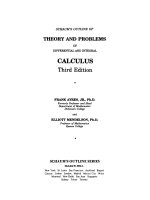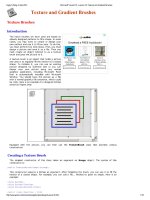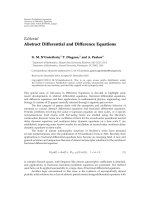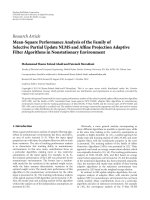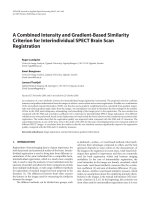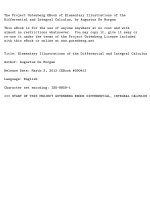Partial derivative, differential and gradient
Bạn đang xem bản rút gọn của tài liệu. Xem và tải ngay bản đầy đủ của tài liệu tại đây (4.04 MB, 48 trang )
<span class="text_page_counter">Trang 1</span><div class="page_container" data-page="1">
FOREIGN TRADE UNIVERSITY
</div><span class="text_page_counter">Trang 2</span><div class="page_container" data-page="2">FOREIGN TRADE UNIVERSITY
</div><span class="text_page_counter">Trang 3</span><div class="page_container" data-page="3">ANALYSIS 1 Quang Dang-Le, Ph.D. Tel. 0764060787
1. PARTIAL DERIVATIVE, DIFFERENTIAL AND GRADIENT. . . . 3
2. PARTIAL DERIVATIVE OF COMPOSITE AND IMPLICIT FUNCTIONS 11 3. THE UNCONDITIONAL EXTREME VALUE. . . . 15
4. THE CONDITIONAL EXTREME VALUE. . . . 20
5. THE MAXIMUM AND MINIMUM VALUE. . . . 22
6. CALCULATE DOUBLE INTEGRAL. . . . 25
7. USING POLAR COORDINATES. . . . 29
8. REVERSING THE ORDER OF INTEGRATION. . . . 32
9. SEPARABLE EQUATIONS. . . . 35
10. THE HOMOGENEOUS EQUATIONS. . . . 38
11. THE EXACT DIFFERENTIAL EQUATIONS. . . . 40
12. LINEAR EQUATION OF FIRST ORDER AND BERNOULLI EQUATION. . .
</div><span class="text_page_counter">Trang 4</span><div class="page_container" data-page="4">ANALYSIS 1 Quang Dang-Le, Ph.D. Tel. 0764060787
1. PARTIAL DERIVATIVE, DIFFERENTIAL AND
D. dz= cos(2x)dx+ sin(2y)dy.5. The first order total differential ofz = e<small>x</small>+e<small>y</small>+ 1is
B. dz= e<small>y</small>dx+ e dy<small>x</small> .
1 PARTIAL DERIVATIVE, DIFFERENTIAL AND GRADIENT 3
</div><span class="text_page_counter">Trang 5</span><div class="page_container" data-page="5">ANALYSIS 1 Quang Dang-Le, Ph.D. Tel. 0764060787
</div><span class="text_page_counter">Trang 6</span><div class="page_container" data-page="6">ANALYSIS 1 Quang Dang-Le, Ph.D. Tel. 0764060787 C. ∇f(x,y,z) = xe<small>y/z</small>,xye ,xze<small>y/zy/z</small> . D. ∇f(x,y,z) = e<small>y/z</small>,xe ,xe<small>y/zy/z</small> . 12. Let f (x,y) = x<small>2</small>+ xcos<small>2</small>y.Find∇f (x,y).
. B. ∇f(x,y) = (2x + cos<small>2</small>y,xsin(2 )).y
C. ∇f(x,y) = (2x + cos<small>2</small>y − xsin(2 )y , −xsin(2 )).y D. ∇f(x,y) = (2x + cos<small>2</small>y,− x2 sin(2 )).y 13. Let z = sin(xy). Calculate z<small>′′xy</small>.
</div><span class="text_page_counter">Trang 7</span><div class="page_container" data-page="7">ANALYSIS 1 Quang Dang-Le, Ph.D. Tel. 0764060787 16. Find the second order differential ofz = 3x<small>3</small>+ 4xy<small>2</small>− 2y<small>3</small>.
B. d<small>2</small>z = 18xdx<small>2</small>+ 8ydxdy+ (8x − 12y)dy<small>2</small>. C. d<small>2</small>z = 18xdx<small>2</small>+ 16ydxdy+ (8x − 6y)dy<small>2</small>. D. d<small>2</small>z = 9xdx<small>2</small>+ 16ydxdy+ (8x − 12 )y dy<small>2</small>.
17. Find the second order differential ofz = x<small>2</small>+ x sin<small>2</small>y. A. d<small>2</small>z = 2dx<small>2</small>+ 2 sin(2y)dxdy+ 2xcos(2 )y dy<small>2</small>.
21. Find the second order total differential ofz = x<small>2</small>+ x sin<small>2</small>y.
1 PARTIAL DERIVATIVE, DIFFERENTIAL AND GRADIENT 6
</div><span class="text_page_counter">Trang 8</span><div class="page_container" data-page="8">ANALYSIS 1 Quang Dang-Le, Ph.D. Tel. 0764060787 B. d<small>2</small>z = 2dx<small>2</small>− 2 sin(2y)dxdy− 2 cos(2 )x y dy<small>2</small>.
C. d<small>2</small>z = 2dx<small>2</small>+ 2 sin(2y)dxdy− x2 cos(2y)dy<small>2</small>. D. d<small>2</small>z = 2dx<small>2</small>+ sin(2y)dxdy+ 2x cos(2 )y dy<small>2</small>. 22. Let z = cos(xy− cos y). Findz<small>xy</small>(0,π/2).
</div><span class="text_page_counter">Trang 9</span><div class="page_container" data-page="9">ANALYSIS 1 Quang Dang-Le, Ph.D. Tel. 0764060787 26. Let z = x<sup>2</sup>y + cos( ) +xy y. Which equality is TRUE?
</div><span class="text_page_counter">Trang 10</span><div class="page_container" data-page="10">ANALYSIS 1 Quang Dang-Le, Ph.D. Tel. 0764060787 30. Let z = e<sup>x+2y</sup>and the following statements Which statement is TRUE?
A. (1),(2) and (3) are true.
B. (1) is true, (2) and (3) are not true. C. (1) and (2) are true, (3) is not true. D. (1) and (3) are true, (2) is not true.
31. Find the partial derivative z<small>xy</small><sup>′′</sup>of z = ln(x<sup>4</sup>+ y<small>2</small>+ 1).
D. dz= (2x − 2y + cos(xy)) dx+ (− x + cos(xy))2 dy. 34. Find the second order differential ofz = xe<small>y</small>.
A. d<small>2</small>z = e<small>y</small>dx<small>2</small>+ e<small>y</small>dxdy+ xe dy<small>y2</small>.
1 PARTIAL DERIVATIVE, DIFFERENTIAL AND GRADIENT 9
</div><span class="text_page_counter">Trang 11</span><div class="page_container" data-page="11">ANALYSIS 1 Quang Dang-Le, Ph.D. Tel. 0764060787
</div><span class="text_page_counter">Trang 12</span><div class="page_container" data-page="12">ANALYSIS 1 Quang Dang-Le, Ph.D. Tel. 0764060787
2. PARTIAL DERIVATIVE OF COMPOSITE AND
2. The composite function z = x + sin y
x <sup>with y = x</sup><sup>2</sup><sup>has derivatives z</sup><sup>′</sup>
3. The composite function z = x + arctan u
v <sup>with u = x sin y, v= x cos y has</sup>
</div><span class="text_page_counter">Trang 13</span><div class="page_container" data-page="13">ANALYSIS 1 Quang Dang-Le, Ph.D. Tel. 0764060787
</div><span class="text_page_counter">Trang 14</span><div class="page_container" data-page="14">ANALYSIS 1 Quang Dang-Le, Ph.D. Tel. 0764060787
</div><span class="text_page_counter">Trang 15</span><div class="page_container" data-page="15">ANALYSIS 1 Quang Dang-Le, Ph.D. Tel. 0764060787 13. Find f<small>′x</small>where f (u,v) = u<sup>2</sup>sin v, u= x<small>2</small>+ y<small>2</small>, v=<sup>y</sup>
</div><span class="text_page_counter">Trang 16</span><div class="page_container" data-page="16">ANALYSIS 1 Quang Dang-Le, Ph.D. Tel. 0764060787
3. THE UNCONDITIONAL EXTREME VALUE
1. Let z = −x<sup>2</sup>+ 4x − 4y<small>2</small>+ 4 + 4y . Which statement is TRUE? A.
B. z reaches its minimum value at M 2,<sup>1</sup> 2 <sup>.</sup> C. z does not have any stationary points. D. z does not have any extreme values.
2. Let z = x<sup>2</sup>− 4x + 4y<small>2</small>− y + 3. Which statement is TRUE?8
B. z reaches its maximum value at M (2 1)., C. z reaches its stationary point M(1 2)., D. z does not have any extreme values.
3. Let z = x<sup>3</sup>− y<small>2</small>− 3x + 6y. Which statement is TRUE? A. z reaches its maximum value at M (1 3).,
B. z reaches its minimum value at N ( 1 3).− , .
D. z does not have any stationary points. 4. Let z = xe<sup>y</sup>+ 5. Which statement is TRUE?
A. M(0, 1) is a stationary point. B. M(1, 0) is a stationary point. C. M(0, 0) is a stationary point. D. z does not have any stationary points.
5. Let z = xe<small>y</small>+ye<small>x</small>+ 2 and M( 1 1)− , − . Which statement is TRUE?
</div><span class="text_page_counter">Trang 17</span><div class="page_container" data-page="17">ANALYSIS 1 Quang Dang-Le, Ph.D. Tel. 0764060787 6. Let z = 4(x − y) − x<sup>2</sup>− y<small>2</small>. Which statement is TRUE?
. B. The minimum value of this function is Z<small>min</small>= 8.
C. This function does not have any maximum or minimum values. D. The maximum value of this function is Z<sub>max</sub>= 9.
7. Let z = 2x<sup>3</sup>− xy<small>2</small>+ 5x<small>2</small>+ y<small>2</small>+ 2. Which statement is TRUE? A. This function reaches its maximum value at O(0 0).,
B. This function reaches its minimum value at O(0 0)., C. This function reaches its minimum value at N(1 0)., D. This function does not have any extreme values. 8. Let z = −x − y + xe<sup>y</sup>+ 5. Which statement is TRUE?
A. This function reaches its maximum value at M(1 0)., B. This function reaches its minimum value at M(1 0)., C. This function does not have any extreme values. D. This function reaches its maximum value at M(1 1)., 9. The function Z = x<sup>3</sup>+ 2xy− 8y<small>3</small>
A. reaches its maximum value at M <sup>1</sup> ,<sup>1</sup>
6 <sup>and z(M) = −</sup> 1 27<sup>.</sup> B. reaches its minimum value at M(0,0) and z(M) = 0.
C. reaches its minimum value at M <sup>1</sup>
10. Find extreme values off(x,y) = x<small>2</small>+ xy+ y<small>2</small>− 3x − 6y.
B. f reaches its maximum value at (0 3)., C. f does not have any extreme values.
D. f has a stationary point (0 3) which is not an extreme point., 11. Given z = x<sup>4</sup>− 8x<small>2</small>+ y<small>2</small>+ 5 and the following points
I(0,0), J(2, 0), K( 2− 0), L, (1, 1). Which statement is TRUE?
3 THE UNCONDITIONAL EXTREME VALUE 16
</div><span class="text_page_counter">Trang 18</span><div class="page_container" data-page="18">ANALYSIS 1 Quang Dang-Le, Ph.D. Tel. 0764060787 A. z reaches its minimum value at J,K.
B. z reaches its maximum value at I,L.
C. z reaches its minimum value at J,K and reaches its maximum value atI,L. D. z reaches its minimum value at I,J,K.
12. Let z = x<sup>3</sup>+ y<small>2</small>+ 27 + 2 + 1x y . Which statement is TRUE?
B. z has two stationary points.
C. z reaches its minimum value at A(3 1)., −
D. z reaches its extreme value at A(3, −1) and B(−3 1)., −
13. Let f (x,y) = −x<sup>2</sup>+ xy+ y<small>2</small>+ x − y + 5. Which statement is TRUE? A. f reaches its minimum value at (3/5 1 5)., /
B. f reaches its minimum value at (3/5 1 5)., / C. f reaches its minimum value at (1/5 3 5)., /
15. Let z = x<sup>2</sup>− y<small>4</small>− 2x + 32y. Which statement is TRUE?
B. z reaches its minimum value at M(1 2)., C. z does not have any stationary points. D. z reaches its maximum value at M(1 2)., 16. The stationary point off(x,y) = (x −1)<small>2</small>+ 2<small>y2</small>is
3 THE UNCONDITIONAL EXTREME VALUE 17
</div><span class="text_page_counter">Trang 19</span><div class="page_container" data-page="19">ANALYSIS 1 Quang Dang-Le, Ph.D. Tel. 0764060787
20. Let z = x<sup>2</sup>− y<small>4</small>− 2x + 32y. Which statement is TRUE? A. z reaches its minimum value at M(1 2).,
B. z reaches its maximum value at M(2 1)., C. z does not have any stationary points.
21. Let z = x<sup>2</sup>− 2y + y<small>2</small>. Which statement is TRUE? A. z reaches its maximum value at (0 1).,
B. z reaches its minimum value at (0 1).,
3 THE UNCONDITIONAL EXTREME VALUE 18
</div><span class="text_page_counter">Trang 20</span><div class="page_container" data-page="20">ANALYSIS 1 Quang Dang-Le, Ph.D. Tel. 0764060787 C. z has a maximum value and a minimum value.
D. z does not have any extreme values.
22. Let z = 3x<sup>2</sup>− 12x + 2y<small>3</small>+ 3y<small>2</small>−12y. Which statement is TRUE? A. z has a maximum value and a minimum value.
B. z has only one maximum value. C. z does not have any stationary points. D. z has only one minimum value. 23. Find extreme values of z = x<sup>2</sup>− 4x + 4
. B. z reaches its maximum value at (2 1)., C. z has a stationary point (1 2)., D. z does not have any extreme values.
24. Find extreme values ofz = −x<small>2</small>+ 4xy− 10y<small>2</small>− 2x + 16y. A. z reaches its minimum value at (1 1).,
C. z reaches its minimum value at (−1 1)., − D. z reaches its maximum value at (−1 1)., −
et z = x<sup>2</sup>− y − ln |y|−2. Which statement is TRUE?
B. z reaches its maximum value at (0 1), − C. z always has partial derivatives on R<small>2</small>.
D. z has a stationary point but does not have any extreme values.
3 THE UNCONDITIONAL EXTREME VALUE 19
</div><span class="text_page_counter">Trang 21</span><div class="page_container" data-page="21">ANALYSIS 1 Quang Dang-Le, Ph.D. Tel. 0764060787
4. THE CONDITIONAL EXTREME VALUE
1. Find the extreme value of z = x<sup>2</sup>(y − 1) − 3x + 2 satisfying thatx − y + 1 = 0. . B. z reaches its minimum value at A(−1,0) and its maximum value at B(1 2)., C. z reaches its maximum value at A(−1,0) and B(1 2).,
D. z reaches its minimum value at A(−1,0) and B(1 2)., 2. Find the extreme value of z =x<small>3</small>
3 <sup>− 3x + y</sup><sup>− 2 satisfying that −x</sup><sup>2</sup><sup>+ + 4 = 0.</sup><sup>y</sup> . B. z reaches its maximum value at A(1, −3) and its minimum value at B(−3 5)., C. z reaches its minimum value at A(1, −3) and B(−3 5).,
D. z reaches its maximum value at A(1, −3) and B( 3 5).− ,
3. Find the extreme value of z = 2x<sup>2</sup>+ y<small>2</small>− 2y − 2 satisfying thaty − x + 1 = 0.
B. z reaches its maximum value at (2/3 1 3)., − /
C. z has a stationary point and does not have any extreme values. D. z does not have any stationary points.
4. Find the extreme value ofz = x<small>2</small>(y + 1) − 3x + 2satisfying thatx + y + 1 = 0. .
B. z reaches its maximum value at (−1,0) and (1 2)., − C. z reaches its minimum value at (−1,0) and (1 2)., −
D. z reaches its maximum value at (−1,0) and its minimum value at (1 2)., − 5. Find the extreme value of z = xysatisfying thatx + y − 1 = 0.
A. z does not have any extreme values.
C. z reaches its minimum value at <sup>2</sup><sup>1</sup>
</div><span class="text_page_counter">Trang 22</span><div class="page_container" data-page="22">ANALYSIS 1 Quang Dang-Le, Ph.D. Tel. 0764060787 6. Find the extreme value ofz = 2x<small>2</small>+ y<small>2</small>− 2y − 2satisfying that−x + y + 1 = 0.
A. z reaches its minimum value at <sup>3</sup> <sup>2</sup> D. z reaches its minimum value at (−3,10) and its maximum value at (1 2)., 8. Find the extreme value of z = x<sup>2</sup>+ y<small>2</small>satisfying thatx + y − 1 = 0.
A. z reaches its maximum value at <sup>2</sup> <sup>1</sup> ,<sup>1</sup>
2 <sup>.</sup> C. z does not have any extreme values.
D. z reaches its minimum value at −<sup>1</sup> , −<sup>1</sup>
2 <sup>.</sup>
4 THE CONDITIONAL EXTREME VALUE 21
</div><span class="text_page_counter">Trang 23</span><div class="page_container" data-page="23">ANALYSIS 1 Quang Dang-Le, Ph.D. Tel. 0764060787
5. THE MAXIMUM AND MINIMUM VALUE
1. Find the maximum and minimum value of functionz = −x + 2 + 3y on the given setD = [0, 1] × [0 1], .
A. The maximum value of zis 5 and the minimum one is 2. B. The maximum value of zis 5 and the minimum one is 3. C. The maximum value of zis 4 and the minimum one is 3. D. The maximum value of zis 4 and the minimum one is 2.
2. Find the maximum and minimum value of functionz = x + 2 + 3xy y − 6on the given setD = [0, 1] × [0 2], .
A. The maximum value of zis 5 and the minimum one is -6. B. The maximum value of zis 5 and the minimum one is -5. C. The maximum value of zis 0 and the minimum one is -6. D. The maximum value of zis 0 and the minimum one is -5.
3. Find the minimum valuemof functionz = ln x − 2yonD = <small>1</small>,1 ×[0,1]. A. m = ln <small>1</small> − 2.
B. m = ln <small>1</small>. C. m = 0.
D. m = − ln <small>1</small> − 2.
4. Let z = x +2 + 3xy y −6 on D = [0, 1] [1× , 2] and the following three statements. (1) The maximum value ofzis 5 atM(1 2), .
(2) The maximum value ofzis -3 atN(0 1), .
5. Find the maximum and minimum value of functionz = x<small>2</small>− 2x − y + 4on the given setD = [0, 1] × [0 1], .
5 THE MAXIMUM AND MINIMUM VALUE 22
</div><span class="text_page_counter">Trang 24</span><div class="page_container" data-page="24">ANALYSIS 1 Quang Dang-Le, Ph.D. Tel. 0764060787 A. The maximum value of zis 4 and the minimum one is 2.
B. The maximum value of zis 4 and the minimum one is 3. C. The maximum value of zis 3 and the minimum one is 2. D. The maximum value of zis 5 and the minimum one is 2.
6. Let z = x<sup>3</sup>− y<small>3</small>+ 5 on the given setD = [0, 1] × [1 2], .Which statement is true? A. The minimum value of zis -3.
B. The maximum value of zis 6. C. The minimum value of zis -2. D. The maximum value of zis 4.
7. Find the maximum valueM and minimum valuemof functionz = x<small>2</small>y<small>2</small>
</div><span class="text_page_counter">Trang 25</span><div class="page_container" data-page="25">ANALYSIS 1 Quang Dang-Le, Ph.D. Tel. 0764060787
</div><span class="text_page_counter">Trang 26</span><div class="page_container" data-page="26">ANALYSIS 1 Quang Dang-Le, Ph.D. Tel. 0764060787
6. CALCULATE DOUBLE INTEGRAL
</div><span class="text_page_counter">Trang 27</span><div class="page_container" data-page="27">ANALYSIS 1 Quang Dang-Le, Ph.D. Tel. 0764060787
</div><span class="text_page_counter">Trang 28</span><div class="page_container" data-page="28">ANALYSIS 1 Quang Dang-Le, Ph.D. Tel. 0764060787
</div><span class="text_page_counter">Trang 29</span><div class="page_container" data-page="29">ANALYSIS 1 Quang Dang-Le, Ph.D. Tel. 0764060787
</div><span class="text_page_counter">Trang 30</span><div class="page_container" data-page="30">ANALYSIS 1 Quang Dang-Le, Ph.D. Tel. 0764060787
7. USING POLAR COORDINATES
1. Calculate I =RR
x<small>2</small>+ y<small>2</small>dxdywhere D is the part of the disk x<small>2</small>+ y<small>2</small>≤ a<small>2</small> that lies in the first quadrant.
1 + x<small>2</small>+ y<small>2</small>dxdy where D is the part of the unit disk that lies in the first quadrant.
</div><span class="text_page_counter">Trang 31</span><div class="page_container" data-page="31">ANALYSIS 1 Quang Dang-Le, Ph.D. Tel. 0764060787
</div><span class="text_page_counter">Trang 32</span><div class="page_container" data-page="32">ANALYSIS 1 Quang Dang-Le, Ph.D. Tel. 0764060787
</div><span class="text_page_counter">Trang 33</span><div class="page_container" data-page="33">ANALYSIS 1 Quang Dang-Le, Ph.D. Tel. 0764060787
8. REVERSING THE ORDER OF INTEGRATION
1. Reverse the order ofR<sub>2</sub>
</div><span class="text_page_counter">Trang 34</span><div class="page_container" data-page="34">ANALYSIS 1 Quang Dang-Le, Ph.D. Tel. 0764060787
<small>D</small>f(x,y dxdy where D is the triangular region with vertices) O(0,0), A(0 1), B(1 1). Which statement is TRUE?, ,
<small>D</small>f(x,y)dxdy where D is the triangular region with vertices C(1,1), A(0, 1), B(1 0). Which statement is TRUE?,
</div><span class="text_page_counter">Trang 35</span><div class="page_container" data-page="35">ANALYSIS 1 Quang Dang-Le, Ph.D. Tel. 0764060787
</div><span class="text_page_counter">Trang 36</span><div class="page_container" data-page="36">ANALYSIS 1 Quang Dang-Le, Ph.D. Tel. 0764060787
5. The solution x = −1 of the differential equationxydx+ (1 + x)dy= 0is called A. the general solution.
B. the particular solution. C. the singular solution.
9 SEPARABLE EQUATIONS 35
</div><span class="text_page_counter">Trang 37</span><div class="page_container" data-page="37">ANALYSIS 1 Quang Dang-Le, Ph.D. Tel. 0764060787 D. the basic solution.
6. The particular solution of (1 + e<sup>x</sup>)yy<small>′</small>= e<small>x</small> satisfying the initial condition
</div><span class="text_page_counter">Trang 38</span><div class="page_container" data-page="38">ANALYSIS 1 Quang Dang-Le, Ph.D. Tel. 0764060787
</div><span class="text_page_counter">Trang 39</span><div class="page_container" data-page="39">ANALYSIS 1 Quang Dang-Le, Ph.D. Tel. 0764060787
10. THE HOMOGENEOUS EQUATIONS
1. Which equation is a homogeneous equation?
</div><span class="text_page_counter">Trang 40</span><div class="page_container" data-page="40">ANALYSIS 1 Quang Dang-Le, Ph.D. Tel. 0764060787 D. y = <sup>x</sup>
C + ln |x|<sup>.</sup>
5. Find the solution of the differential equation y<sup>′</sup>= <sup>y</sup>
x<sup>+ 1 with the initial</sup>
</div><span class="text_page_counter">Trang 41</span><div class="page_container" data-page="41">ANALYSIS 1 Quang Dang-Le, Ph.D. Tel. 0764060787
11. THE EXACT DIFFERENTIAL EQUATIONS
1. Which equation is an exact differential equation?
A. e<small>x</small>(y − x<small>2</small>)dx+ (e<small>x</small>− y<small>2</small>sin y dy= 0.) B. e<small>x</small>(y<small>2</small>+ x dx+ (e) <small>x</small>+ x<small>2</small>sin y dy= 0.) C. e<small>x</small>(y − x<small>2</small>)dx+ (e<small>x</small>+ x<small>2</small>sin y dy= 0.) D. e<small>x</small>(y<small>2</small>+ x dx+ (e) <small>x</small>− y<small>2</small>sin y)dy= 0.
2. Which equation is an exact differential equation?
A. (ye<small>x</small>− x sin x)dx+ (e<small>x</small>− y cos y dy= 0.) B. (ye<small>x</small>− x sin y)dx+ (e<small>x</small>− y cos y dy= 0.) C. (ye<small>x</small>− x sin x)dx+ (e<small>x</small>− x cos y dy= 0.) D. (ye<small>x</small>− x sin y)dx+ (e<small>x</small>− x cos y dy= 0.)
3. Which equation is an exact differential equation?
A. (ye<small>x</small>−xe<small>x</small>)dx+ e<small>x</small>− y<small>2</small>sin y dy= 0.) B. (ye<small>x</small>+ xe<small>x</small>)dx+ (e<small>x</small>+ x<small>2</small>sin y dy= 0.) C. (ye<small>x</small>+ xe<small>x</small>)dx+ (e<small>x</small>+ y<small>2</small>sin y dy= 0.) D. (ye<small>x</small>−xe<small>y</small>)dx+ (e<small>x</small>− y<small>2</small>sin y)dy= 0.
4. Which equation is an exact differential equation?
A. (y sinx − cos y)dx− (cos x − xsiny)dy= 0. B. (y sinx − cos y)dx+ (cos x − xsiny)dy= 0. C. (y sinx + cos y)dx+ (cos x + xsiny)dy= 0. D. (y sinx + cos y)dx− (cos x − xsiny)dy= 0.
5. Which equation is NOT an exact differential equation?
A. (ye<small>x</small>− x sin x)dx+ (e<small>x</small>− x cos y dy= 0.) B. (ye<small>x</small>+ y<small>2</small>sin x)dx+ (e<small>x</small>− y cos x dy= 0.2 ) C. (ye<small>x</small>− x sin x)dx+ (e<small>x</small>− y cos y dy= 0.) D. (ye<small>x</small>− sin y)dx+ (e<small>x</small>− x cos y dy= 0.)
11 THE EXACT DIFFERENTIAL EQUATIONS 40
</div><span class="text_page_counter">Trang 42</span><div class="page_container" data-page="42">ANALYSIS 1 Quang Dang-Le, Ph.D. Tel. 0764060787
12. LINEAR EQUATION OF FIRST ORDER AND
</div><span class="text_page_counter">Trang 43</span><div class="page_container" data-page="43">ANALYSIS 1 Quang Dang-Le, Ph.D. Tel. 0764060787 into the linear equation of first order.
12 LINEAR EQUATION OF FIRST ORDER AND BERNOULLI EQUATION 42
</div><span class="text_page_counter">Trang 44</span><div class="page_container" data-page="44">ANALYSIS 1 Quang Dang-Le, Ph.D. Tel. 0764060787 A. Let z = y<small>4</small>, the equation becomes z<small>′</small>− 4z = 2x + 1.
B. Let z = y<small>4</small>, the equation becomes z<small>′</small>− z = 4(2x + 1). C. Let z =<sup>y</sup>
x<sup>, the equation becomes 4z</sup><sup>′</sup><sup>− 4z = 2 +</sup> 1 x<sup>.</sup> D. Let y = ux, the equation becomes y<small>′</small>= x + xu<small>′</small>.
12 LINEAR EQUATION OF FIRST ORDER AND BERNOULLI EQUATION 43
</div><span class="text_page_counter">Trang 45</span><div class="page_container" data-page="45">ANALYSIS 1 Quang Dang-Le, Ph.D. Tel. 0764060787
13. HOMOGENEOUS LINEAR EQUATION OF SEC-OND ORDER WITH CONSTANT COEFFICIENTS
1. Find the general solution of the differential equationy<small>′′</small>− 3y<small>′</small>+ 2y = 0.
</div><span class="text_page_counter">Trang 46</span><div class="page_container" data-page="46">ANALYSIS 1 Quang Dang-Le, Ph.D. Tel. 0764060787 6. The solution ofy<small>′′</small>− 5y<small>′</small>+ 6 = 0, y(0) = 2, y<small>′</small>(0) = 3is
</div><span class="text_page_counter">Trang 47</span><div class="page_container" data-page="47">ANALYSIS 1 Quang Dang-Le, Ph.D. Tel. 0764060787
14. NONHOMOGENEOUS EQUATION OF SECOND
</div><span class="text_page_counter">Trang 48</span><div class="page_container" data-page="48">ANALYSIS 1 Quang Dang-Le, Ph.D. Tel. 0764060787 6. The general solution ofy<small>′′</small>+ 3y<small>′</small>− 4y = xis
</div>


